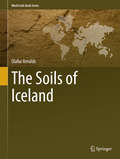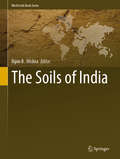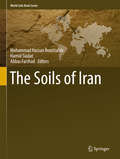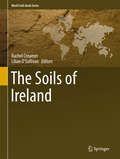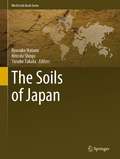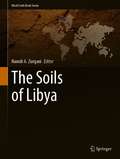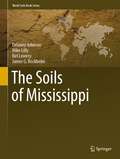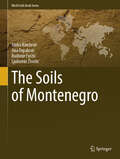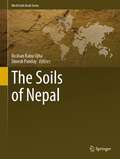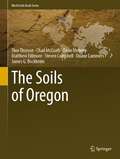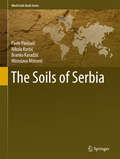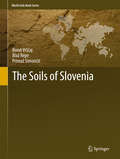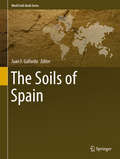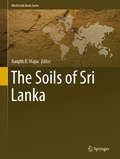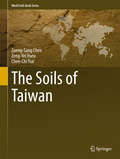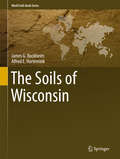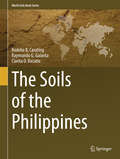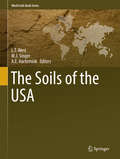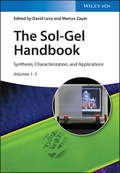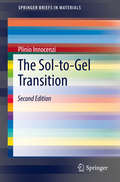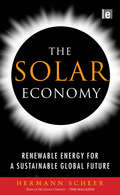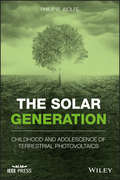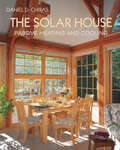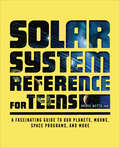- Table View
- List View
The Soils of Iceland
by Olafur ArnaldsIn this new volume in the World Soil series, the various types of Icelandic soils, their different characteristics, their formation, degradation and erosion are reviewed. At the same time, the book also deals with the agriculture and land use in general to give a complete view of Icelandic soils. The first part details the natural parameters such as the climate and the geography of Iceland. It also explains Icelandic geology, which is the major parameter controlling the soil formation in this country. The author describes the formation of Iceland, the main volcanic systems, central volcanoes, tephra production and its influence on the soils. Explanations on rocks, glaciers, rivers and other main geologic features are also given. The book continues with a description of the Icelandic geomorphology, giving insights on the main surface types, frost, cryoturbation and other cryogenic features. Then it details the different types of soils, their formation and main features, comparing the Icelandic soils to other soils elsewhere in the world. Erosion and land degradation are then reviewed, including the exceptionally active wind erosion and dust production. Finally, it gives an insight on land use, agriculture and vegetation types. All this accompanied by the most amazing photos to illustrate the great diversity of Icelandic Soil.
The Soils of India (World Soils Book Series)
by Bipin B. MishraThis book provides an overview of the diversified soil regimes in India. In addition to the historical advances in soil research and its limitations, it describes the monitoring of various soil conditions and soil uses to improve productivity. Discussing topics such as climate, geology and geomorphology, major soil types and their classification, soil mineralogy and clays, soil micromorphology, soil biogeochemistry, benchmark soils, land evaluation and land use planning, soil health and fertility and soil resilience, the book highlights the multiple uses of soils in industry, human health care, mitigation of challenges due to climate change and construction. It also presents measures for a brighter future of soil science in India, such as imposing organic farming principles toward sustainable agriculture in the context of the second green revolution besides alleviating the poverty and providing the employment opportunities among the farming communities in India.
The Soils of Iran (World Soils Book Ser.)
by Mohammad Hassan Roozitalab Hamid Siadat Abbas FarshadThis unique book addresses Iran’s extremely rich soil diversity and resources, which have developed under various climatic conditions ranging from dry to humid conditions. Featuring contributions by a group of respected experts on Iranian soils and agriculture, it provides comprehensive information on the management approaches needed for sustainable soil utilization and conservation under such conditions, and the attendant challenges. As such, it offers a valuable resource for anyone interested in soils and agriculture in Iran, but also in other Middle East and North African countries with similar climatic conditions. The book contains 14 chapters which illustrate the long history of indigenous knowledge and soil research, climate, geology and geomorphology, vegetation cover, soil forming factors and processes, major soils, properties and their classification. Furthermore, it presents past climate change and paleosols, agroecological zones, soil fertility, soil biology and biotechnology, human induced land degradation and “soil management in space and time”. In the end, major challenges facing the soil resources of the country are defined and recommendations are made to face the future challenges.
The Soils of Ireland (World Soils Book Ser.)
by Rachel Creamer Lilian O’SullivanThis book provides a comprehensive overview of pedology in Ireland. It describes the main soil types of the country, their functions, ecological use, and the conditions to which they were subjected associated with management over time. In addition, it presents a complete set of data, pictures and maps, including benchmark profiles. Factors involved in soil formation are also discussed, making use of new, unpublished data and elaborations. The book was produced with the support and sponsorship of Teagasc, The Agriculture and Food Development Authority, Ireland and the Irish Environmental Protection Agency.
The Soils of Japan (World Soils Book Series)
by Ryusuke Hatano Hitoshi Shinjo Yusuke TakataThis book provides an overview of the distribution, properties, and function of soils in Japan. First, it offers general descriptions of the country’s climate, geology, geomorphology, and land use, the history of the Japanese soil classification system and characteristics and genesis of major soil types follow. For each region – a geographic/administrative region of the country – there is a chapter with details of current land use as well as properties and management challenges of major soils. Maps of soil distribution, pedon descriptions, profile images, and tables of properties are included throughout the text and appendices.
The Soils of Korea (World Soils Book Series)
by Jae YangThis book offers an in-depth exploration of Korean soils, emphasizing their unique characteristics, historical significance, and innovative management practices. Soil is the foundation of life on Earth, providing essential resources for food, clothing, and shelter. In Korea, soil management has been pivotal in shaping agriculture, economy, culture, and environmental sustainability. Over the decades, Korean agriculture has evolved significantly, transitioning from production-focused strategies in the mid-twentieth century to sustainable and eco-friendly practices in recent years. Korean soil scientists have been at the forefront of these advancements, pioneering innovations in soil classification, fertilization programs, and the application of technologies like artificial intelligence. These contributions have established Korea as a global leader in soil science, highlighted by its successful hosting of the 2014 World Congress of Soil Science. This comprehensive book examines Korea&’s soil types, primarily derived from igneous and metamorphic rocks, and their diverse applications in rice paddies, upland fields, and greenhouses. It also explores the cultural and ecological value of soil, including its role in shaping Korean traditions and its contribution to ecosystem services. This book is an essential resource for researchers, policymakers, and anyone interested in soil science and sustainability. This book provides valuable insights into the profound ways soil has shaped Korea&’s past, present, and future, offering a window into one of the world&’s most dynamic soil landscapes.
The Soils of Libya (World Soils Book Series)
by Hamdi A. ZurqaniThis book presents the soil pedodiversity in Libya. Soils are the source of all life; there can be no life without them. Further, each soil has its own history and its present conditions, which have been shaped by many different factors (e.g. climate, biota, parent material, and relief or topography). The book, divided into eight chapters, provides extensive information on Libyan soils. Chapter one provides an introduction and a broad perspective of the subject, while Chapter two covers the history of soil mapping and research in Libya. Chapter three focuses on local factors of soil formation and describes the geology and climate of the region to explain the diversity of its soils. Chapter four discusses soil classification systems and those most commonly used in the country. The fifth chapter illustrates the constraints and limiting factors that negatively affect agricultural activities across the country. The land cover/land use and the vegetation of the country are described in Chapter six. In turn, Chapter seven presents the status quo of soil biology, the corresponding related research activities, and the other biological properties of Libyan soils. The final chapter (Chapter eight) focus on land degradation and desertification in Libya, emphasizing the main causes, impacts of the phenomena, and efforts to combat it. This book demonstrates the problems that the country is currently facing as a result of climate change, soil erosion, salinization, and pollution, and outlines potential remedies to improve local food security. Bringing together the perspectives and expertise of many distinguished scientists from various universities and institutions in and outside of Libya, the book represents a unique and highly valuable resource.
The Soils of Mississippi (World Soils Book Series)
by James G. Bockheim Delaney Johnson Mike Lilly Birl LoweryThis book capitalizes on data collected by the Natural Resources Conservation Service & other organizations over the past 100+ years & offers the first comprehensive treatment of Mississippi soils. Main topics include the history of soil studies; soil-forming factors; general soil regions; taxonomic soil regions; soil-forming processes; benchmark, endemic, rare, & endangered soils; land use; key environmental issues; & yield potential of Mississippi soils. The book contains over 100 photographs of soils, vegetation, & land use & should be of interest to planners & students interested in soil science & allied disciplines.
The Soils of Montenegro (World Soils Book Series)
by Mirko Knežević Ana Topalović Budimir Fuštić Ljubomir ŽivotićDesigned to give the reader as much information and data on soil in Montenegro as possible, this book compiles all available data on soils of Montenegro and describes the genesis, morphology, physical and chemical properties of soils. It also deals with the current situation and future use of soil cover, in order to provide more information about the composition, characteristics and problems of Montenegrin soils. The classification, occurrence and distribution of some types, subtypes and varieties of soil (together with the main physical, chemical and biological characteristics and properties) are explained with the emphasis on factors of soil formation in Montenegro. The treated themes are introduced in easily accessible way, making it usable both by professionals and by anyone interested in soil use.
The Soils of Nepal (World Soils Book Series)
by Roshan Babu Ojha Dinesh PandayThis book publishes consolidated information on the soils of Nepal from all possible sources. The Survey Department, Government of Nepal, conducted two national scale soil survey projects to classify soils of Nepal (Land Resource Mapping Project ended in 1985, and National Land Use Planning Project ended in 2021). Both projects adopted the United States Department of Agriculture system of soil classification. Besides, National Soil Science Research Center (previously known as Soil Science Division) of Nepal Agricultural Research Council and Soil Management Directorate, Department of Agriculture, also worked on soils of Nepal. To date, the information on the soils of Nepal is not published in well-documented form but has been reported widely as gray literature (project report or government report) or peer-review articles.'The Soils of Nepal’ is a part of ‘World Soils Book Series’ which constitutes twelve chapters—covering broad aspects such as soil research history, climate, geology, soil classification and mapping, and soil fertility. Furthermore, information about soil properties and relation between soil constituents of the dominant soil types of Nepal and their scope of use in the context of land use are described. This book also tries to simplify the intricate relationship among soil, culture, and people. Each chapter contains a comprehensive, richly illustrated, and up-to-date overview of the soils of Nepal. We believe it fulfils a quest for a global audience including students, educators, extension workers, and soil scientists, who are interested to know the young soils of Nepal.
The Soils of Oregon (World Soils Book Series)
by Steven Campbell James G. Bockheim Thor Thorson Chad McGrath Dean Moberg Matthew Fillmore Duane LammersThis book is the only comprehensive summary of natural resources of Oregon and adds to World Soil Book Series state-level collection. Due to broad latitudinal and elevation differences, Oregon has an exceptionally diverse climate, which exerts a major influence on soil formation. The mean annual temperature in Oregon ranges from 0°C in the Wallowa and Blue Mountains of northeastern Oregon to 13 °C in south-central Oregon. The mean annual precipitation ranges from 175 mm in southeastern Oregon to over 5,000 mm at higher elevations in the Coast Range. The dominant vegetation type in Oregon is temperate shrublands, followed by forests dominated by lodgepole pine, Douglas-fir, and mixed conifers, grasslands, subalpine forests, maritime Sitka spruce-western hemlock forests, and ponderosa pine-dominated forests. Oregon is divided into 17 Major Land Resource Areas, the largest of which include the Malheur High Plateau, the Cascade Mountains, the Blue Mountain Foothills, and Blue Mountains. The single most important geologic event in Oregon was the deposition of Mazama ash 7,700 years by the explosion of Mt. Mazama. Oregon has soil series representative of 10 orders, 40 suborders, 114 great groups, 389 subgroups, over 1,000 families, and over 1,700 soil series. Mollisols are the dominant order in Oregon, followed by Aridisols, Inceptisols, Andisols, Ultisols, and Alfisols. Soils in Oregon are used primarily for forest products, livestock grazing, agricultural crops, and wildlife management. Key land use issues in Oregon are climate change; wetland loss; flooding; landslides; volcanoes, earthquakes, and tsunamis; coastal erosion; and wildfires.
The Soils of Serbia
by Pavle Pavlović Nikola Kostić Branko Karadžić Miroslava MitrovićThe main objective of this book is to present the distribution and diversity of major soil types in Serbia. It focuses on giving a detailed description of the physical, chemical and biological properties of soil and their geomorphological forms, as well as the geological characteristics of parent material. An integrative approach is used to study the interaction between climate, vegetation and geology in soil formation. Special attention is paid to human-induced soil degradation due to the erosion and contamination of soils in Serbia. The book includes a harmonization of national soil classification systems, with the FAO, WBR and ESD systems.
The Soils of Slovenia
by Borut Vrščaj Blaž Repe Primož SimončičThis books gives a complete overview of the Soils of Slovenia, from soil research history, climate, geology, geomorphology, major soil types, soil maps, soil propoerties, classification, fertility, land use and vegetation, soil management, soils and humans, soils and industries and future soils issues.
The Soils of Spain
by Juan F. GallardoThis book provides the reader with a comprehensive overview of the soils of Spain gathered by a variety of Spanish experts in the field. It presents soils in this country as particularly conditioned by the naturally diverse and drastic distribution of the Spanish landscape, characterized by mountainous ranges in the North, and arid areas in the South and the East. The first chapter sets the agricultural scenario in Spain as influenced by the Arabic culture and American agricultural products; the second chapter provides a classification and distribution of Spanish soils; the third chapter approaches the topic of soils in the characteristically humid Northern Iberia area as prone to diversity and soil evolution; the fourth focuses on the soils of the South and East of Spain as affected by lack of rainfall and abundance in calcic soil horizons; the fifth chapter deals with Mediterranean soils, having as a particular characteristic the dominance of red colors; and the last chapter discusses the challenges and future issues of Spanish soils.
The Soils of Sri Lanka (World Soils Book Series)
by Ranjith B. MapaThis book presents a comprehensive and up-to-date overview of the soils of Sri Lanka. Including sections on the soil research history, climate, geology, geomorphology, major soil types, soil maps, soil properties, soil classification, soil fertility, land use and vegetation, soil management, soils and humans, soils and industry, and future soil issues, the book summarizes the current state of knowledge in a concise and highly reader-friendly way.
The Soils of Taiwan
by Zueng-Sang Chen Zeng-Yei Hseu Chen-Chi TsaiThis book presents a comprehensive and up-to-date overview on soils of Taiwan. It includes sections on soil research history, climate, geology, geomorphology, major soil types, soil maps, soil properties, soil classification, soil fertility, land use and vegetation, soil management, soils and humans, soils and industry, future soil issues. The book summarizes what is known about the soils in Taiwan in a concise and highly reader-friendly way.
The Soils of Wisconsin
by James G. Bockheim Alfred E. HarteminkThis book provides an up-to-date and comprehensive report on the soils of Wisconsin, a state that offers a rich tapestry of soils. It discusses the relevant soil forming factors and soil processes in detail and subsequently reviews the main soil regions and dominant soil orders, including paleosols and endemic and endangered soils. The last chapters address soils in a changing climate and provide an evaluation of their monetary value and crop yield potential. Richly illustrated, the book offers both a valuable teaching resource and essential guide for policymakers, land users, and all those interested in the soils of Wisconsin.
The Soils of the Philippines
by Rodelio B. Carating Raymundo G. Galanta Clarita D. BacatioThe first soil survey in the Philippines was done by Mr. Clarence Dorsey, an American soil scientist in the province of Batangas in 1903. The Soils of the Philippines, however, is the first comprehensive summary of more than a century of soil-survey work in this country. It integrates the soil concepts of the reconnaissance soil-survey results, which commenced as early as 1934 and continued until the mid 1960s, with the semi-detailed soil surveys that continue to this day. The result is the first-ever genetic key for classifying Philippine soils at soil series level; thus, making it possible for any newcomers to the soil survey field to confidently produce their own soil map, at a more detailed map scale, to suit the project requirements. This book brings together discussions on soils and soil mapping units and up-to-date international techniques and technologies. It makes soils relevant to current political realities and national issues. As soil survey moves from a reductionist agricultural-development planning tool to a more holistic and integrated approach, to enable us to understand our dynamic and complex environment, The Soils of the Philippines will be the only source of authoritative and updated data on soil resources for macro-level resource management planning for decades to come. With a vanishing breed of experienced soil surveyors, not only in the Philippines but also worldwide, it may remain the only book on Philippine soils for the next hundred years or more. Since soils follow a geological and not a human time frame, the contents of this volume will stay relevant for soil surveyors even in a fast changing world. As the country leaps from an agricultural economy towards modernization and a more diversified economic base, some of the soil series in the Philippines, for example the Guadalupe series underlying the skyscrapers of Makati City, are becoming extinct as a result of urban development. Therefore, this book serves as the repository for the soils that we possess, the soils that have been lost through decades of urbanization while, at the same time, it creates a soil classification system for the soils we are yet to discover.
The Soils of the USA
by L. T. West M. J. Singer A. E. HarteminkThis book provides an overview of the distribution, properties, and function of soils in the U. S. , including Alaska, Hawaii, and its Caribbean territories. It discusses the history of soil surveys and pedological research in the U. S. , and offers general descriptions of the country's climate, geology and geomorphology. For each Land Resource Region (LRR) - a geographic/ecological region of the country characterized by its own climate, geology, landscapes, soils, and agricultural practices - there is a chapter with details of the climate, geology, geomorphology, pre-settlement and current vegetation, and land use, as well as the distribution and properties of major soils including their genesis, classification, and management challenges. The final chapters address topics such as soils and humans, and the future challenges for soil science and soil surveys in the U. S. Maps of soil distribution, pedon descriptions, profile images, and tables of properties are included throughout the text.
The Sol-Gel Handbook
by David Levy Marcos ZayatThis comprehensive three-volume handbook brings together a review of the current state together with the latest developments in sol-gel technology to put forward new ideas. The first volume, dedicated to synthesis and shaping, gives an in-depth overview of the wet-chemical processes that constitute the core of the sol-gel method and presents the various pathways for the successful synthesis of inorganic and hybrid organic-inorganic materials, bio- and bio-inspired materials, powders, particles and fibers as well as sol-gel derived thin films, coatings and surfaces. The second volume deals with the mechanical, optical, electrical and magnetic properties of sol-gel derived materials and the methods for their characterization such as diffraction methods and nuclear magnetic resonance, infrared and Raman spectroscopies. The third volume concentrates on the various applications in the fields of membrane science, catalysis, energy research, biomaterials science, biomedicine, photonics and electronics.
The Sol-to-Gel Transition (SpringerBriefs in Materials)
by Plinio InnocenziThis book provides an in-depth introduction to the sol to gel transition in inorganic and hybrid organic-inorganic systems, one of the most important chemical-physical transitions and the basis of the sol-gel process. Familiarity with the fundamental chemistry and physics of this transition is essential for students in chemistry and materials science through academic and industry researchers working on sol-gel-related applications. The book features a didactic approach, using simple and clear language to explain the sol to gel transition and the accompanying processes. The text is also suitable for use in short courses and workshops for graduate students as well as professionals.This fully revised and updated new edition contains a wealth of new content. In particular, it includes a detailed discussion of the chemistry of transition metal alkoxides and organosilanes, and an extended discussion of the sol to gel transition models.
The Solar Economy: Renewable Energy for a Sustainable Global Future
by Hermann ScheerThe global economy and our way of life are based on the exploitation of fossil fuels, which not only threaten massive environmental and social disruption through global warming but, at present rates of consumption, will run out within decades, causing huge industrial dislocation and economic collapse. Even before then, the conflicts it causes in the Middle East and elsewhere will be frighteningly exacerbated. The alternative exists: renewable energy from renewable sources - above all, solar. Substituting renewable for fossil resources will take a new industrial revolution to avert the worst of the damage and establish a new international order. It can be done, and it can be done in time. The Solar Economy, by one of the world's most effective analysts and advocates, lays out the blueprints, showing how the political, economic and technological challenges can be met using indigenous, renewable and universally available resources, and the enormous opportunities and benefits that will flow from doing so.
The Solar Generation: Childhood and Adolescence of Terrestrial Photovoltaics
by Philip R. WolfeThe first book to address the early development of the photovoltaic industry, and the pioneering researchers and companies in the sector Well before the end of this century, solar power will be the world's dominant power source. This book looks at the origins of this smart sustainable energy technology, tracing the pioneering years from its inception following the 1973 oil crisis to the end of the last millennium—just as the sector was poised for explosive growth. It focuses on the progress of the early terrestrial photovoltaic sector, often in the face of skepticism or apathy. It also covers the research and achievements of people and organizations within the PV business. Written by a leader in the field with more than 40 years of experience and an international reputation in the sustainable energy industry, The Solar Generation: Childhood and Adolescence of Terrestrial Photovoltaics offers enlightening coverage on the terrestrial PV industry. The first part of this 3-volume set provides a historical backdrop to the technology and tracks the development of research, markets, prices, applications, policies, and more. Part II is called the ‘encyclopedia’ and features a Who’s Who of the most influential people and profiles of key companies, events, and developments. Finally, Part III is the reference section and comes complete with glossaries, bibliography, and an incredibly comprehensive index. This text also: Addresses the early development of the PV sector from a global perspective Focuses on a defined period, leaving scope for later follow-ups as the sector matures Offers a study on the interactions between technology, policy, and market drivers The Solar Generation is an ideal book for all professionals in the power and energy field from every corner of the globe.
The Solar House: Passive Heating and Cooling
by Daniel D. ChirasPassive solar heating and passive cooling—approaches known as natural conditioning—provide comfort throughout the year by reducing, or eliminating, the need for fossil fuel. Yet while heat from sunlight and ventilation from breezes is free for the taking, few modern architects or builders really understand the principles involved.Now Dan Chiras, author of the popular book The Natural House, brings those principles up to date for a new generation of solar enthusiasts.The techniques required to heat and cool a building passively have been used for thousands of years. Early societies such as the Native American Anasazis and the ancient Greeks perfected designs that effectively exploited these natural processes. The Greeks considered anyone who didn't use passive solar to heat a home to be a barbarian!In the United States, passive solar architecture experienced a major resurgence of interest in the 1970s in response to crippling oil embargoes. With grand enthusiasm but with scant knowledge (and sometimes little common sense), architects and builders created a wide variety of solar homes. Some worked pretty well, but looked more like laboratories than houses. Others performed poorly, overheating in the summer because of excessive or misplaced windows and skylights, and growing chilly in the colder months because of insufficient thermal mass and insulation and poor siting.In The Solar House, Dan Chiras sets the record straight on the vast potential for passive heating and cooling. Acknowledging the good intentions of misguided solar designers in the past, he highlights certain egregious—and entirely avoidable—errors. More importantly, Chiras explains in methodical detail how today's home builders can succeed with solar designs.Now that energy efficiency measures including higher levels of insulation and multi-layered glazing have become standard, it is easier than ever before to create a comfortable and affordable passive solar house that will provide year-round comfort in any climate.Moreover, since modern building materials and airtight construction methods sometimes result in air-quality and even toxicity problems, Chiras explains state-of-the-art ventilation and filtering techniques that complement the ancient solar strategies of thermal mass and daylighting. Chiras also explains the new diagnostic aids available in printed worksheet or software formats, allowing readers to generate their own design schemes.
The Solar System Reference for Teens: A Fascinating Guide to Our Planets, Moons, Space Programs, and More
by Dr. Bruce BettsTake a tour of our solar system with this guide for teens ages 12 to 16 From the moons of Jupiter to the surface of Mars, our solar system is home to a multitude of wild, weird worlds. Crack open this solar system book and embark on a journey through space as you meet key figures in history, explore careers in astronomy, uncover some of the solar system's biggest mysteries, and more. Tons of images—Bring celestial objects into focus through more than 160 images, illustrations, and diagrams that provide a close-up look into our solar system and how it works. Fascinating facts—Did you know the Moon gets farther from Earth each year at about the same rate that your fingernails grow? Discover all sorts of awe-inspiring facts about our solar system's planets, moons, and more. Exciting exploration—Learn about important historical achievements and technological developments—including missions to different parts of the solar system—and get tips for your own stargazing sessions. Explore all the cool stuff in our solar system with this accessible reference guide for teens.
